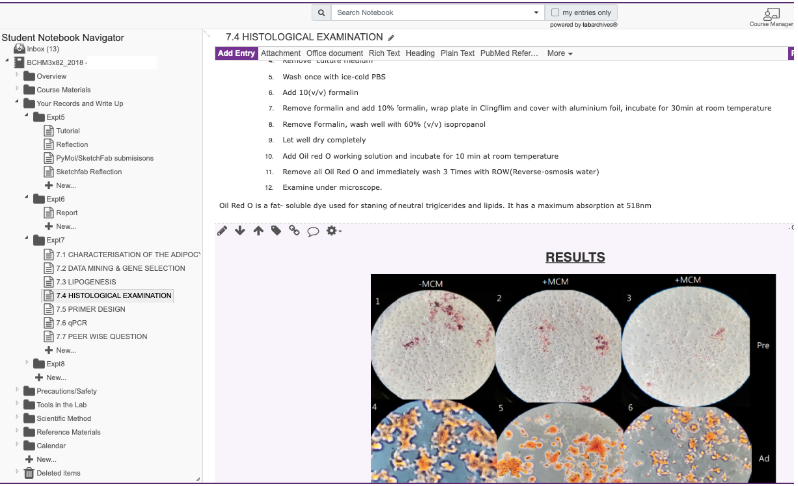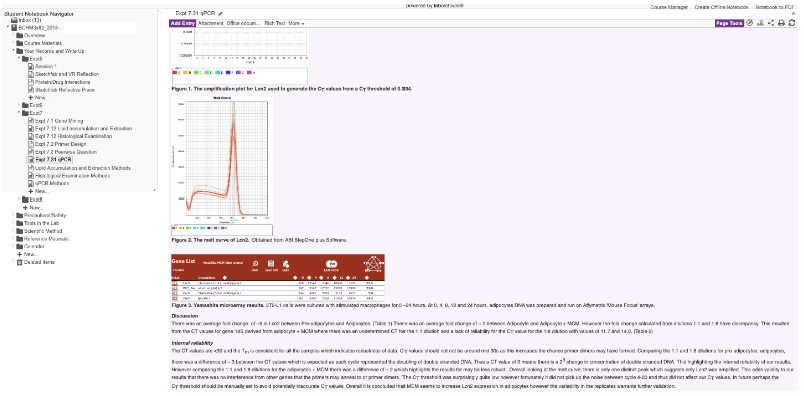This week we’ve got an in depth look at how some of our southern hemisphere friends are using LabArchives in a BIG way. Meet Gareth Denyer, Professor of biochemical education at the University of Sydney in Australia. He has been using LabArchives since 2013 and tackles course instruction with a digital platform in a pretty interesting way.
So what is his philosophy around using a digital platform in his courses?
“I want students to structure their notebooks like they would if they were in a research lab. I don’t want them to have a formulaic approach. I set the standards but I leave the structure of the lab notebook up to my students. This rewards students’ creativity and power of discernment.”
Giving students decision making power helps prepare them for real world STEM work and promotes critical decision making and analytical skills. Gareth incorporates this thinking into his use of LabArchives and also uses LabArchives to curate data on his course, his student’s work and their progress over time.
 Gareth Denyer
Gareth DenyerCreative vs. Formulaic
Gareth’s students are all responsible for their own individual notebooks. Even so, students often work at the bench in pairs. However, Gareth requires students to complete their own individual notebooks, “to curate their own data and then to weave their own contextual narrative around that data.” Other LabArchives professors use the group submission function so students can submit work collaboratively. Both approaches work and are reflected in the platform’s grade book and the instructor’s dashboard.
Paired lab work benefits instructors, TAs and students. Student pairs problem solve together and teach one another along the way. Instructors and TAs are able to run lab sessions smoothly with fewer repeated questions and fewer lab stations. By requiring each student to submit their own work, Gareth ensures that all students are actively participating in and understanding the entire life cycle of the lab experiment from bench work to write up and submission.
Gareth’s approach encourages students to make their own decisions within their notebook. He tells them what a “good” lab notebook should look like, sets standards and then leaves the rest up to them. Students are forced to ask themselves questions:
- How best can I organize this data?
- How best can I present this data for the reader to understand?
- Will I be able to understand this six years from now?
- How should my lab report flow?
- Is it clear what is original data and what are calculated values?
Over time student’s learn to ask themselves the right questions and to make decisions that lead to a comprehensive lab writeup and overall notebook. By not giving his students formulas and formats Gareth’s course “rewards creativity” and instills an active decision making process in students that can be used in any academic writing or reporting.
While Gareth certainly goes about his day to day course instruction in an intentional way he is also thinking BIG picture. Gareth doesn’t just use LabArchives as his course platform but also as a source of course data over time.
 A well organized notebook from one of Gareth’s students.
A well organized notebook from one of Gareth’s students.Gathering intelligence on a course
One of the LabArchives functions that Gareth appreciates most is the ability to access and refer back to student notebooks from one, two, three… however many years ago. This capability has more than a few applications as there is a lot of data contained within LabArchives…..
“Traditional” data found in LabArchives:
- Student course grades
- Assignment grades
- Lab report grades
Now let’s challenge what we consider to be “data” for a second.. Other “data” found in LabArchives:
- Quality of notebook organization
- Quality of student write ups
- Student use of images/videos/figures in reports
- Student engagement with content through comments, mentions, etc.
By virtue of having years of student notebooks at his fingertips Gareth can ask questions about his course and his students and arrive at insights over time:
- Is there a lab experiment that has garnered consistent high quality student write ups?
- Or one that hasn’t?
- Have student’s taken advantage of digital tools to submit better more comprehensive work?
- Are student notebooks better organized in regards to certain assignments/topics?
- How has the practical class been performing over the years? What is the quality of the data? Are the results equivocal or too straightforward? How are the students handling the techniques?
- Can we leverage previous years’ data to make the practicals more of an extension rather than more recipe following?
By asking these questions and using the data available to him, Gareth can analyze his course, continue doing what works and update what doesn’t. He can get a sense of students’ progress over time, see where their successes and failures occur and continue pushing his course instruction to lead to the best student learning outcomes possible.
No matter how big or small a course is, after just a few years of using LabArchives instructors will have amassed a large data set on their students’ work that is both data driven and stylistically driven.
Using this data in real time
You might be thinking sure that all sounds great, but I don’t have a few years. I want to know how my students are learning and track their progress NOW! The good news is that you don’t have to wait. As Gareth knows, getting a pulse on who is engaged in his course and who isn’t literally takes a minute. The activity feed in LabArchives allows Gareth to view and sort all student activities. He can see who is active in the course notebook and who is not. Lack of engagement often = falling behind. With very little time invested, Gareth can pull a short list of who may not be keeping up. Identifying these students early makes it easier to bring them up to speed before the semester is too far gone.
With a digital course platform instructors and TAs don’t have to wait for students to physically turn in their notebook to get a glimpse of student progress. Feedback can be given via the platform at any time. Instructors and TAs can view work in process, offer low stakes feedback before work is submitted or even reopen graded work for student revisions.
 By analyzing student notebooks over time, Gareth can better understand trends in student work and his course instruction.
By analyzing student notebooks over time, Gareth can better understand trends in student work and his course instruction.So how do you make the jump?
For starters, just do it. Paper is old school. Paper management is a hassle. Notebooks are heavy. Student’s expect to access their course content digitally just as they access everything else. TAs lives will be easier. Everyone wins. When Gareth made the jump he “hadn’t realized the importance of using LabArchives exactly as a professional lab notebook, curating the data, including raw data, making copies of process data, and having a narrative to bind all of that together.” But once you get the hang of LabArchives the work your students will do in LabArchives is actually a “tremendous legacy to leave for their future selves.” And the LabArchives support squad is here to assist at each step of the way with free course design services and roll out help!

















